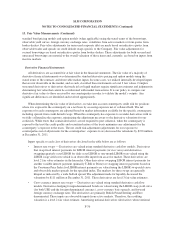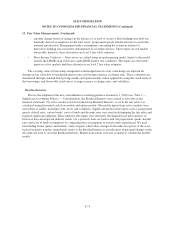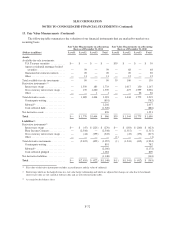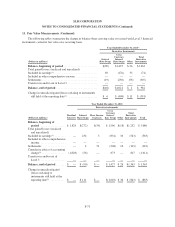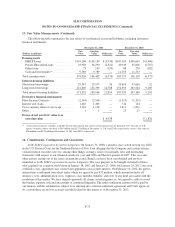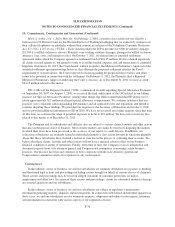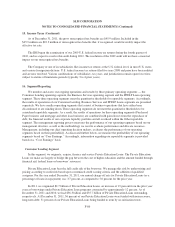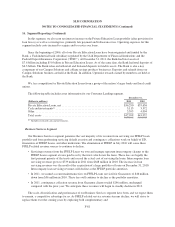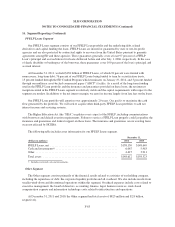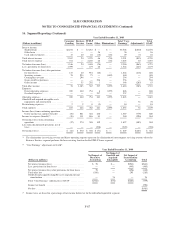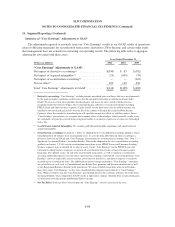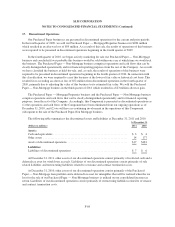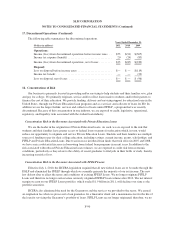Sallie Mae 2011 Annual Report Download - page 189
Download and view the complete annual report
Please find page 189 of the 2011 Sallie Mae annual report below. You can navigate through the pages in the report by either clicking on the pages listed below, or by using the keyword search tool below to find specific information within the annual report.SLM CORPORATION
NOTES TO CONSOLIDATED FINANCIAL STATEMENTS (Continued)
15. Income Taxes (Continued)
As of December 31, 2011, the gross unrecognized tax benefits are $45.9 million. Included in the
$45.9 million are $22.3 million of unrecognized tax benefits that, if recognized, would favorably impact the
effective tax rate.
The IRS began the examination of our 2009 U.S. federal income tax returns during the fourth quarter of
2010, and we expect to resolve this audit during 2012. The resolution of the 2009 audit will not have a material
impact on our unrecognized tax benefits.
The Company or one of its subsidiaries files income tax returns at the U.S. federal level, in most U.S. states,
and various foreign jurisdictions. U.S. federal income tax returns filed for years 2008 and prior have been audited
and are now resolved. Various combinations of subsidiaries, tax years, and jurisdictions remain open for review,
subject to statute of limitations periods (typically 3 to 4 prior years).
16. Segment Reporting
We monitor and assess our ongoing operations and results by three primary operating segments — the
Consumer Lending operating segment, the Business Services operating segment and the FFELP Loan operating
segment. These three operating segments meet the quantitative thresholds for reportable segments. Accordingly,
the results of operations of our Consumer Lending, Business Services and FFELP Loans segments are presented
separately. We have smaller operating segments that consist of business operations that have either been
discontinued or are winding down. These operating segments do not meet the quantitative thresholds to be
considered reportable segments. As a result, the results of operations for these operating segments (Purchased
Paper business and mortgage and other loan business) are combined with gains/losses from the repurchase of
debt, the financial results of our corporate liquidity portfolio and all overhead within the Other reportable
segment. The management reporting process measures the performance of our operating segments based on our
management structure, as well as the methodology we used to evaluate performance and allocate resources.
Management, including our chief operating decision makers, evaluates the performance of our operating
segments based on their profitability. As discussed further below, we measure the profitability of our operating
segments based on “Core Earnings.” Accordingly, information regarding our reportable segments is provided
based on a “Core Earnings” basis.
Consumer Lending Segment
In this segment, we originate, acquire, finance and service Private Education Loans. The Private Education
Loans we make are largely to bridge the gap between the cost of higher education and the amount funded through
financial aid, federal loans or borrowers’ resources.
Private Education Loans bear the full credit risk of the borrower. We manage this risk by underwriting and
pricing according to credit risk based upon customized credit scoring criteria and the addition of qualified
cosigners. For the year ended December 31, 2011, our annual charge-off rate for Private Education Loans (as a
percentage of loans in repayment) was 3.7 percent, as compared to 5.0 percent for the prior year.
In 2011, we originated $2.7 billion of Private Education Loans, an increase of 19 percent from the prior year
even as borrowings under Private Education Loan programs contracted by approximately 12 percent. As of
December 31, 2011 and 2010, we had $36.3 billion and $35.7 billion of Private Education Loans outstanding,
respectively. At December 31, 2011, 56 percent of our Private Education Loans were funded with non-recourse,
long-term debt; 51 percent of our Private Education Loans being funded to term by securitization trusts.
F-80


